A Molecular Genetic Analysis of RPE65-Associated Forms of Inherited Retinal Degenerations in the Russian Federation
Abstract
:1. Introduction
2. Materials and Methods
3. Results
4. Discussion
Author Contributions
Funding
Institutional Review Board Statement
Informed Consent Statement
Data Availability Statement
Acknowledgments
Conflicts of Interest
References
- Bertelsen, M.; Jensen, H.; Bregnhøj, J.F.; Rosenberg, T. Prevalence of generalized retinal dystrophy in Denmark. Ophthalmic Epidemiol. 2014, 21, 217–223. [Google Scholar] [CrossRef] [PubMed]
- Liew, G.; Michaelides, M.; Bunce, C. A comparison of the causes of blindness certifications in England and Wales in working age adults (16–64 years), 1999–2000 with 2009–2010. BMJ Open 2014, 4, e004015. [Google Scholar] [CrossRef] [PubMed]
- Puech, B.; Kostrubiec, B.; Hache, J.C.; François, P. Epidémiologie et prévalence des principales dystrophies rétiniennes héréditaires dans le Nord de la France [Epidemiology and prevalence of hereditary retinal dystrophies in the Northern France]. J. Fr. Ophtalmol. 1991, 14, 153–164. [Google Scholar]
- Morimura, H.; Fishman, G.A.; Grover, S.A.; Fulton, A.B.; Berson, E.L.; Dryja, T.P. Mutations in the RPE65 gene in patients with autosomal recessive retinitis pigmentosa or leber congenital amaurosis. Proc. Natl. Acad. Sci. USA 1998, 95, 3088–3093. [Google Scholar] [CrossRef] [PubMed]
- Moiseyev, G.; Chen, Y.; Takahashi, Y.; Wu, B.X.; Ma, J.X. RPE65 is the isomerohydrolase in the retinoid visual cycle. Proc. Natl. Acad. Sci. USA 2005, 102, 12413–12418. [Google Scholar] [CrossRef]
- Imanishi, Y.; Batten, M.L.; Piston, D.W.; Baehr, W.; Palczewski, K. Noninvasive two-photon imaging reveals retinyl ester storage structures in the eye. J. Cell Biol. 2004, 164, 373–383. [Google Scholar] [CrossRef] [PubMed]
- Jang, G.-F.; Van Hooser, J.P.; Kuksa, V.; McBee, J.K.; He, Y.-G.; Janssen, J.J.M.; Driessen, C.A.G.G.; Palczewski, K. Characterization of a dehydrogenase activity responsible for oxidation of 11-cis-retinol in the retinal pigment epithelium of mice with a disrupted RDH5 gene. A model for the human hereditary disease fundus albipunctatus. J. Biol. Chem. 2001, 276, 32456–32465. [Google Scholar] [CrossRef]
- Kiser, P.D. Retinal pigment epithelium 65 kDa protein (RPE65): An update. Prog. Retin. Eye Res. 2022, 88, 101013. [Google Scholar] [CrossRef]
- Kiser, P.D.; Farquhar, E.R.; Shi, W.; Sui, X.; Chance, M.R.; Palczewski, K. Structure of RPE65 isomerase in a lipidic matrix reveals roles for phospholipids and iron in catalysis. Proc. Natl. Acad. Sci. USA 2012, 109, E2747–E2756. [Google Scholar] [CrossRef]
- Testa, F.; Murro, V.; Signorini, S.; Colombo, L.; Iarossi, G.; Parmeggiani, F.; Falsini, B.; Salvetti, A.P.; Brunetti-Pierri, R.; Aprile, G.; et al. RPE65-Associated Retinopathies in the Italian Population: A Longitudinal Natural History Study. Investig. Opthalmol. Vis. Sci. 2022, 63, 13. [Google Scholar] [CrossRef]
- Lopez-Rodriguez, R.; Lantero, E.; Blanco-Kelly, F.; Avila-Fernandez, A.; Merida, I.M.; del Pozo-Valero, M.; Perea-Romero, I.; Zurita, O.; Jiménez-Rolando, B.; Swafiri, S.T.; et al. RPE65-related retinal dystrophy: Mutational and phenotypic spectrum in 45 affected patients. Exp. Eye Res. 2021, 212, 108761. [Google Scholar] [CrossRef] [PubMed]
- Astuti, G.D.N.; Bertelsen, M.; Preising, M.N.; Ajmal, M.; Lorenz, B.; Faradz, S.M.H.; Qamar, R.; Collin, R.W.J.; Rosenberg, T.; Cremers, F.P.M. Comprehensive genotyping reveals RPE65 as the most frequently mutated gene in Leber congenital amaurosis in Denmark. Eur. J. Hum. Genet. 2016, 24, 1071–1079. [Google Scholar] [CrossRef]
- Available online: https://ngs-data-ccu.epigenetic.ru/ (accessed on 12 September 2023).
- Ryzhkova, O.P.; Kardymon, O.L.; Prohorchuk, E.B.; Konovalov, F.A.; Maslennikov, A.B.; Stepanov, V.A.; Afanasyev, A.A.; Zaklyazminskaya, E.V.; Kostareva, A.A.; Pavlov, A.E.; et al. Guidelines for the interpretation of massive parallel sequencing variants (update 2018, v2). Med. Genet. 2019, 18, 3–23. (In Russian) [Google Scholar] [CrossRef]
- Stepanova, A.A.; Kadyshev, V.V.; Shchagina, O.A.; Polyakov, A.V. Selective screening of patients with hereditary retinal degeneration to identify the target group for gene therapy with voretigene neparvovec. Med. Genet. 2022, 21, 51–55. (In Russian) [Google Scholar] [CrossRef]
- Dharmaraj, S.; Silva, E.; Pina, A.L.; Li, Y.Y.; Yang, J.M.; Carter, R.C.; Loyer, M.; El-Hilali, H.; Traboulsi, E.; Sundin, O.; et al. Mutational analysis and clinical correlation in Leber congenital amaurosis. Ophthalmic Genet. 2000, 21, 135–150. [Google Scholar] [CrossRef] [PubMed]
- Thompson, D.A.; Gyürüs, P.; Fleischer, L.L.; Bingham, E.L.; McHenry, C.L.; Apfelstedt–Sylla, E.; Zrenner, E.; Lorenz, B.; Richards, J.E.; Jacobson, S.G.; et al. Genetics and phenotypes of RPE65 mutations in inherited retinal degeneration. Investig. Ophthalmol. Vis. Sci. 2000, 41, 4293–4299. [Google Scholar]
- Gu, S.-M.; Thompson, D.A.; Srikumari, C.S.; Lorenz, B.; Finckh, U.; Nicoletti, A.; Murthy, K.; Rathmann, M.; Kumaramanickavel, G.; Denton, M.J.; et al. Mutations in RPE65 cause autosomal recessive childhood-onset severe retinal dystrophy. Nat. Genet. 1997, 17, 194–197. [Google Scholar] [CrossRef]
- Marlhens, F.; Griffoin, J.M.; Bareil, C.; Arnaud, B.; Claustres, M.; Hamel, C.P. Autosomal recessive retinal dystrophy associated with two novel mutations in the RPE65 gene. Eur. J. Hum. Genet. 1998, 6, 527–531. [Google Scholar] [CrossRef]
- Weleber, R.G.; Michaelides, M.; Trzupek, K.M.; Stover, N.B.; Stone, E.M. The phenotype of Severe Early Childhood Onset Retinal Dystrophy (SECORD) from mutation of RPE65 and differentiation from Leber congenital amaurosis. Investig. Opthalmol. Vis. Sci. 2011, 52, 292–302. [Google Scholar] [CrossRef]
- Henderson, R.H.; Waseem, N.; Searle, R.; van der Spuy, J.; Russell-Eggitt, I.; Bhattacharya, S.S.; Thompson, D.A.; Holder, G.E.; Cheetham, M.E.; Webster, A.R.; et al. An assessment of the apex microarray technology in genotyping patients with Leber congenital amaurosis and early-onset severe retinal dystrophy. Investig. Opthalmol. Vis. Sci. 2007, 48, 5684–5689. [Google Scholar] [CrossRef]
- Weisschuh, N.; Obermaier, C.D.; Battke, F.; Bernd, A.; Kuehlewein, L.; Nasser, F.; Zobor, D.; Zernner, E.; Weber, E.; Wissinger, B.; et al. Genetic architecture of inherited retinal degeneration in Germany: A large cohort study from a single diagnostic center over a 9-year period. Hum. Mutat. 2020, 41, 1514–1527. [Google Scholar] [CrossRef]
- Li, S.; Xiao, X.; Yi, Z.; Sun, W.; Wang, P.; Zhang, Q. RPE65 mutation frequency and phenotypic variation according to exome sequencing in a tertiary centre for genetic eye diseases in China. Acta Ophthalmol. 2020, 98, e181–e190. [Google Scholar] [CrossRef] [PubMed]
- Yang, G.; Liu, Z.; Xie, S.; Li, C.; Lv, L.; Zhang, M.; Zhao, J. Genetic and phenotypic characteristics of four Chinese families with fundus albipunctatus. Sci. Rep. 2017, 7, 46285. [Google Scholar] [CrossRef] [PubMed]
- Zampaglione, E.; Kinde, B.; Place, E.M.; Navarro-Gomez, D.; Maher, M.; Jamshidi, F.; Nassiri, S.; Mazzone, J.A.; Finn, C.; Schlegel, D.; et al. Copy-number variation contributes 9% of pathogenicity in the inherited retinal degenerations. Genet. Med. 2020, 22, 1079–1087. [Google Scholar] [CrossRef] [PubMed]
- Simovich, M.J.; Miller, B.; Ezzeldin, H.; Kirkland, B.T.; McLeod, G.; Fulmer, C.; Nathans, J.; Jacobson, S.G.; Pittler, S.J. Four novel mutations in the RPE65 gene in patients with Leber congenital amaurosis. Hum. Mutat. 2001, 18, 164. [Google Scholar] [CrossRef] [PubMed]
- Thompson, D.A.; McHenry, C.L.; Li, Y.; Richards, J.E.; Othman, M.I.; Schwinger, E.; Vollrath, D.; Jacobson, S.G.; Gal, A. Retinal dystrophy due to paternal isodisomy for chromosome 1 or chromosome 2, with homoallelism for mutations in RPE65 or MERTK, respectively. Am. J. Hum. Genet. 2002, 70, 224–229. [Google Scholar] [CrossRef]
- Motta, F.L.; Filippelli-Silva, R.; Kitajima, J.P.; Batista, D.A.; Wohler, E.S.; Sobreira, N.L.; Martin, R.P.; Sallum, J.M.F. Analysis of an NGS retinopathy panel detects chromosome 1 uniparental isodisomy in a patient with RPE65-related leber congenital amaurosis. Ophthalmic Genet. 2021, 42, 553–560. [Google Scholar] [CrossRef]
- Fingert, J.H.; Eliason, D.A.; Phillips, N.C.; Lotery, A.J.; Sheffield, V.C.; Stone, E.M. Case of stargardt disease caused by uniparental isodisomy. Arch. Ophthalmol. 2006, 124, 744. [Google Scholar] [CrossRef]
- Rivolta, C.; Berson, E.L.; Dryja, T.P. Paternal uniparental heterodisomy with partial isodisomy of chromosome 1 in a patient with retinitis pigmentosa without hearing loss and a missense mutation in the Usher syndrome type II gene USH2A. Arch. Ophthalmol. 2002, 120, 1566–1571. [Google Scholar] [CrossRef]
- Stone, E.M. Leber congenital amaurosis–a model for efficient genetic testing of heterogeneous disorders: LXIV Edward Jackson memorial lecture. Am. J. Ophthalmol. 2007, 144, 791–811.e6. [Google Scholar] [CrossRef]
- Sallum, J.M.F.; Kaur, V.P.; Shaikh, J.; Banhazi, J.; Spera, C.; Aouadj, C.; Viriato, D.; Fischer, M.D. Epidemiology of Mutations in the 65-kDa Retinal Pigment Epithelium (RPE65) Gene-Mediated Inherited Retinal Dystrophies: A Systematic Literature Review. Adv. Ther. 2022, 39, 1179–1198. [Google Scholar] [CrossRef] [PubMed]
- Verma, A.; Perumalsamy, V.; Shetty, S.; Kulm, M.; Sundaresan, P. Mutational screening of LCA genes emphasizing RPE65 in South Indian cohort of patients. PLoS ONE 2013, 8, e73172. [Google Scholar] [CrossRef] [PubMed]
- Motta, F.L.; Martin, R.P.; Porto, F.B.O.; Wohler, E.S.; Resende, R.G.; Gomes, C.P.; Pesquero, J.B.; Sallum, J.M.F. Pathogenicity Reclasssification of RPE65 Missense Variants Related to Leber Congenital Amaurosis and Early-Onset Retinal Dystrophy. Genes 2019, 11, 24. [Google Scholar] [CrossRef] [PubMed]
- Colombo, L.; Maltese, P.E.; Castori, M.; El Shamieh, S.; Zeitz, C.; Audo, I.; Zulian, A.; Marinelli, C.; Benedetti, S.; Costantini, A.; et al. Molecular Epidemiology in 591 Italian Probands With Nonsyndromic Retinitis Pigmentosa and Usher Syndrome. Investig. Opthalmology Vis. Sci. 2021, 62, 13. [Google Scholar] [CrossRef]
- Zhong, Z.; Rong, F.; Dai, Y.; Yibulayin, A.; Zeng, L.; Liao, J.; Wang, L.; Huang, Z.; Zhou, Z.; Chen, J. Seven novel variants expand the spectrum of RPE65-related Leber congenital amaurosis in the Chinese population. Mol. Vis. 2019, 25, 204–214. [Google Scholar] [PubMed]
- Chung, D.C.; Bertelsen, M.; Lorenz, B.; Pennesi, M.E.; Leroy, B.P.; Hamel, C.P.; Pierce, E.; Sallum, J.; Larsen, M.; Stieger, K.; et al. The Natural History of Inherited Retinal Dystrophy Due to Biallelic Mutations in the RPE65 Gene. Am. J. Ophthalmol. 2019, 199, 58–70. [Google Scholar] [CrossRef] [PubMed]
- Philp, A.; Jin, M.; Li, S.; Schindler, E.; Iannaccone, A.; Lam, B.; Weleber, R.; Fishman, G.; Jacobson, S.; Mullins, R.; et al. Predicting the pathogenicity of RPE65 mutations. Hum. Mutat. 2009, 30, 1183–1188. [Google Scholar] [CrossRef]
- Sallum, J.M.F.; Motta, F.L.; Arno, G.; Porto, F.B.O.; Resende, R.G.; Belfort, R., Jr. Clinical and molecular findings in a cohort of 152 Brazilian severe early onset inherited retinal dystrophy patients. Am. J. Med. Genet. C Semin. Med. Genet. 2020, 184, 728–752. [Google Scholar] [CrossRef]
- Zenteno, J.C.; García-Montaño, L.A.; Cruz-Aguilar, M.; Ronquillo, J.; Rodas-Serrano, A.; Aguilar-Castul, L.; Matsui, R.; Vencedor-Meraz, C.I.; Arce-González, R.; Graue-Wiechers, F.; et al. Extensive genic and allelic heterogeneity underlying inherited retinal dystrophies in Mexican patients molecularly analyzed by next-generation sequencing. Mol. Genet. Genom. Med. 2020, 8. [Google Scholar] [CrossRef]
- Vázquez-Domínguez, I.; Duijkers, L.; Fadaie, Z.; Alaerds, E.C.W.; Post, M.A.; van Oosten, E.M.; O’gorman, L.; Kwint, M.; Koolen, L.; Hoogendoorn, A.D.M.; et al. The Predicted Splicing Variant c.11+5G>A in RPE65 Leads to a Reduction in mRNA Expression in a Cell-Specific Manner. Cells 2022, 11, 3640. [Google Scholar] [CrossRef]
- Jin, M.; Li, S.; Hu, J.; Jin, H.H.; Jacobson, S.G.; Bok, D. Functional Rescue of Retinal Degeneration-Associated Mutant RPE65 Proteins. Adv. Exp. Med. Biol. 2016, 854, 525–532. [Google Scholar] [CrossRef] [PubMed]
- Schwarz, J.M.; Rodelsperger, C.; Schuelke, M.; Seelow, D. Mutation Taster evaluates disease-causing potential of sequence alterations. Nat. Methods 2010, 7, 575–576. [Google Scholar] [CrossRef] [PubMed]
- Shihab, H.A.; Gough, J.; Cooper, D.N.; Stenson, P.D.; Barker, G.L.; Edwards, K.J.; Day, I.N.; Gaunt, T.R. Predicting the functional, molecular, and phenotypic consequences of amino acid substitutions using hidden Markov models. Hum. Mutat. 2013, 34, 57–65. [Google Scholar] [CrossRef] [PubMed]
- Chun, S.; Fay, J.C. Identification of deleterious mutations within three human genomes. Genome Res. 2009, 19, 1553–1561. [Google Scholar] [CrossRef] [PubMed]
- Raimondi, D.; Tanyalcin, I.; Ferté, J.; Gazzo, A.; Orlando, G.; Lenaerts, T.; Rooman, M.; Vranken, W. DEOGEN2: Prediction and interactive visualization of single amino acid variant deleteriousness in human proteins. Nucleic Acids Res. 2017, 45, W201–W206. [Google Scholar] [CrossRef]
- Smith, A.J.; Bainbridge, J.W.; Ali, R.R. Gene supplementation therapy for recessive forms of inherited retinal dystrophies. Gene Ther. 2012, 19, 154–161. [Google Scholar] [CrossRef]
- Kang, C.; Scott, L.J. Voretigene Neparvovec: A Review in RPE65 Mutation-Associated Inherited Retinal Dystrophy. Mol. Diagn. Ther. 2020, 24, 487–495. [Google Scholar] [CrossRef]
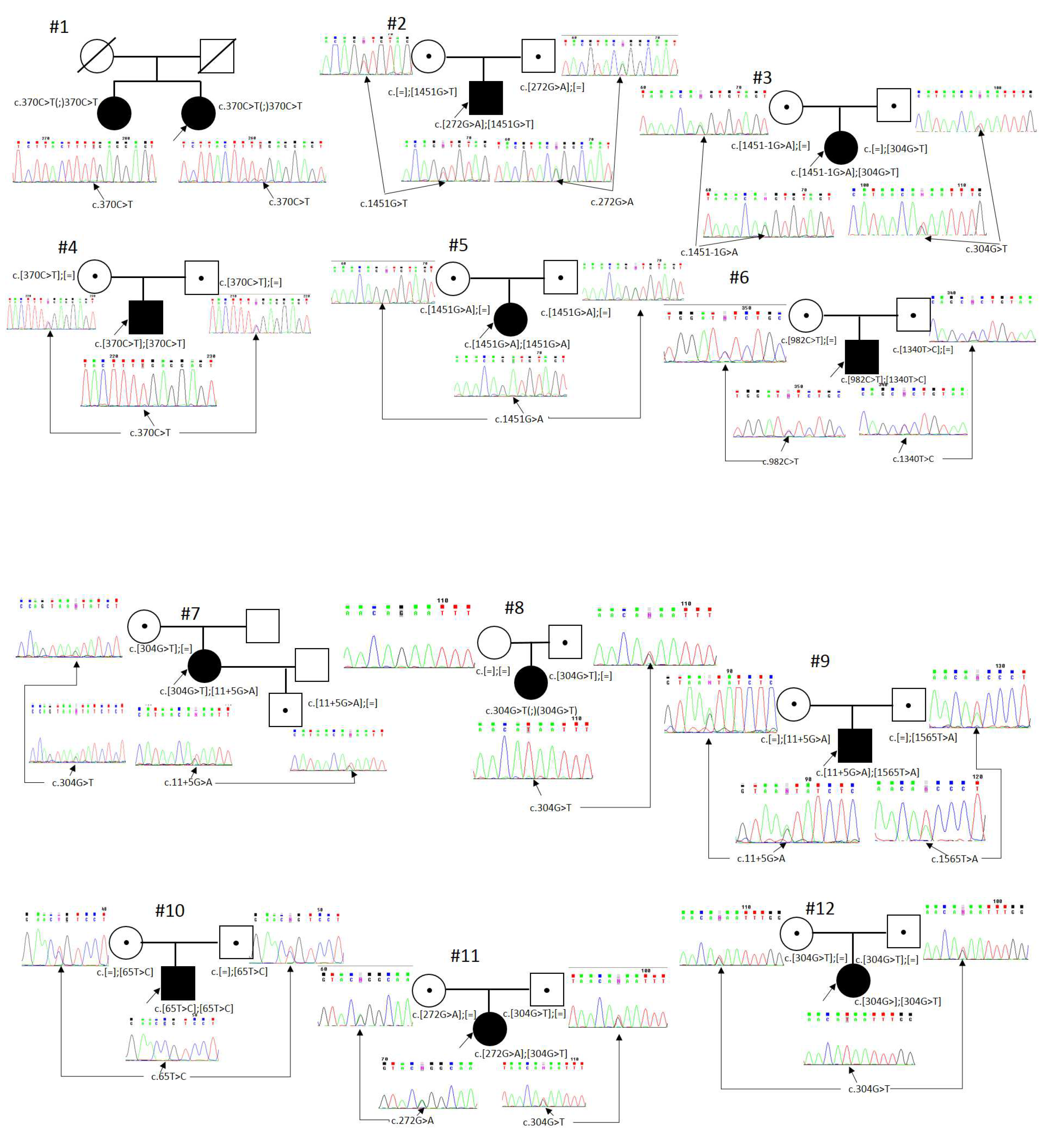
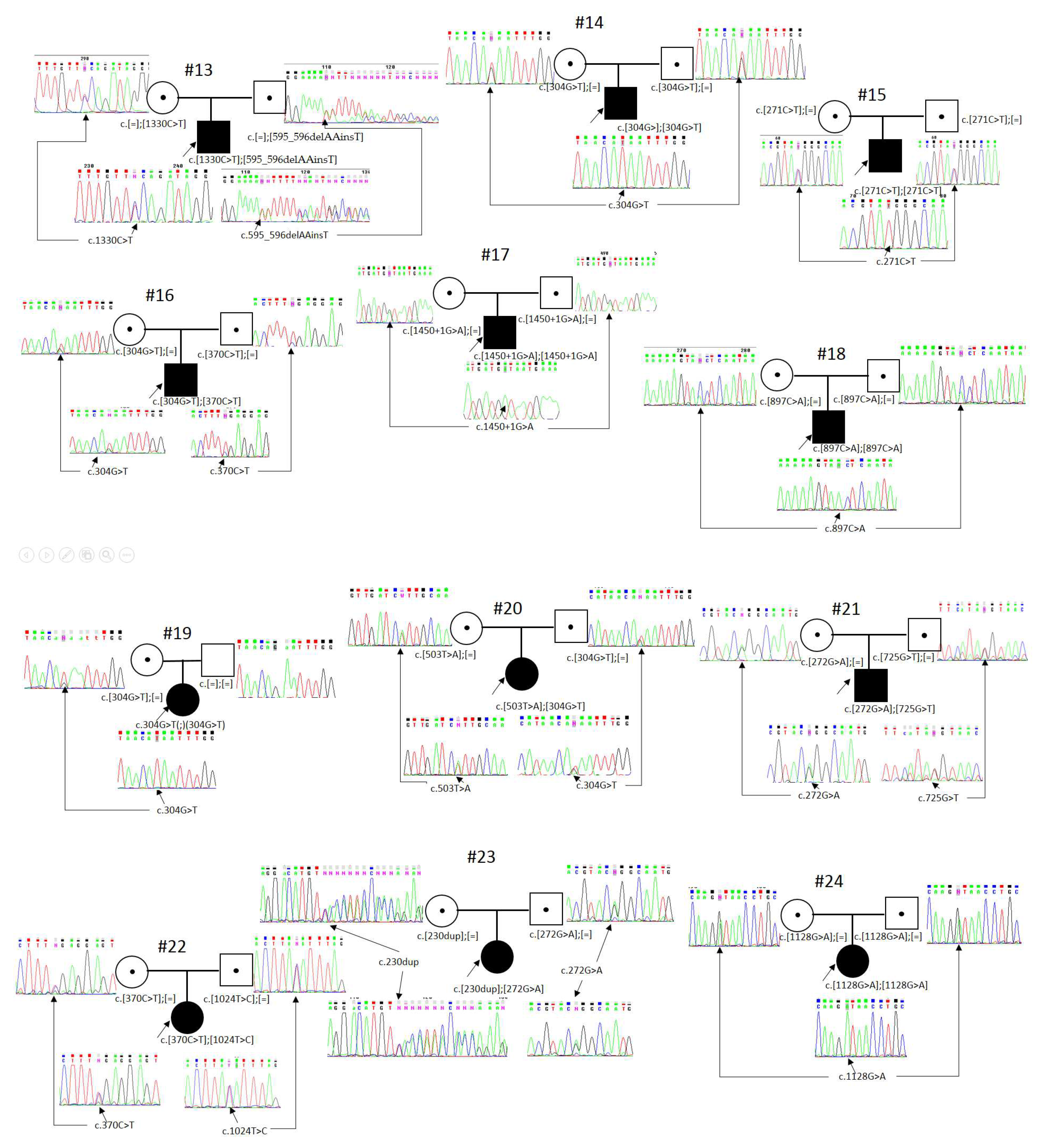
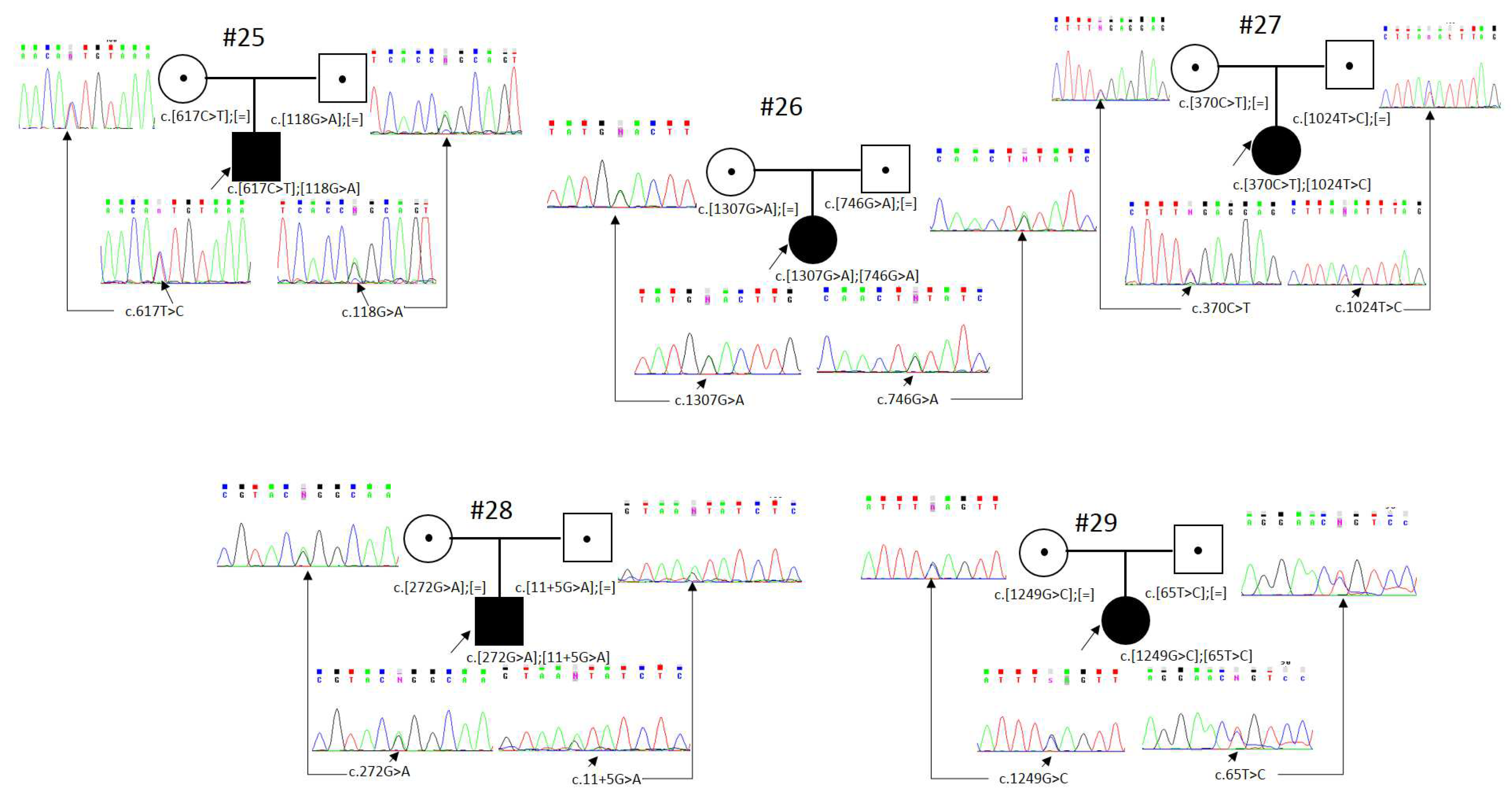

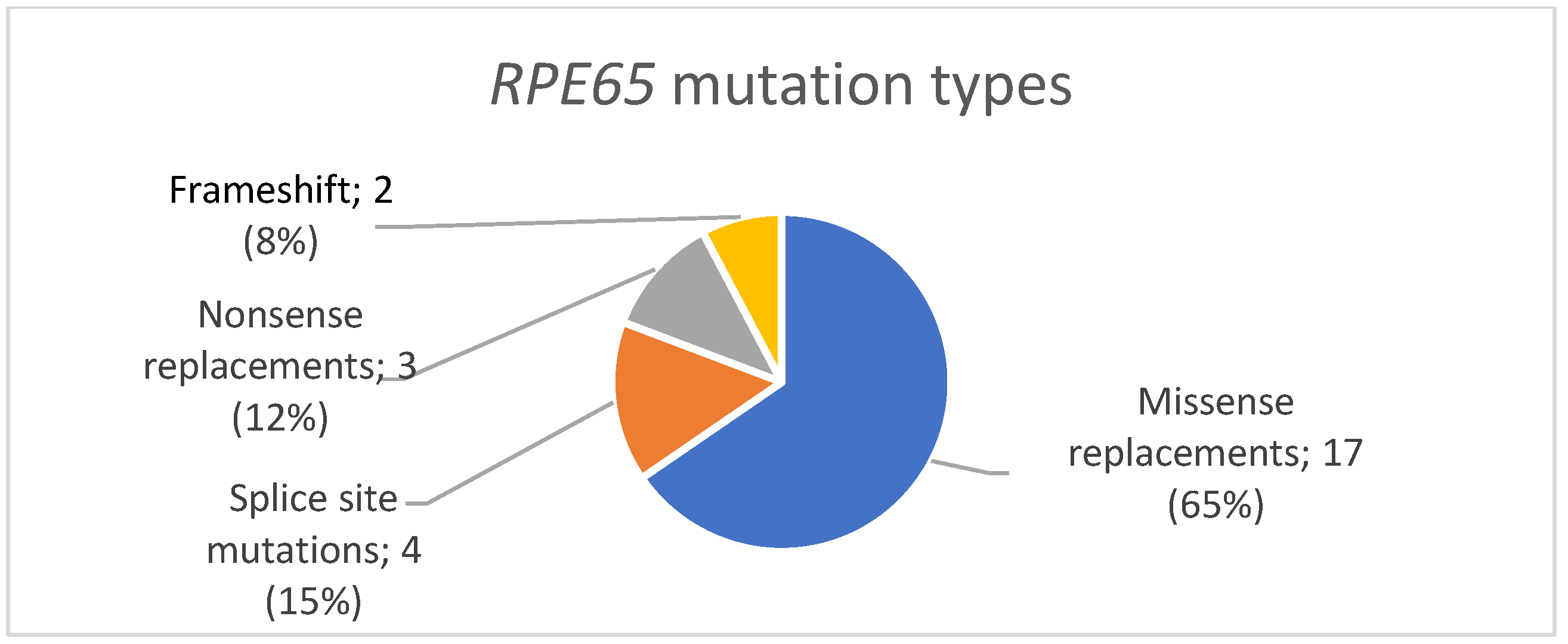
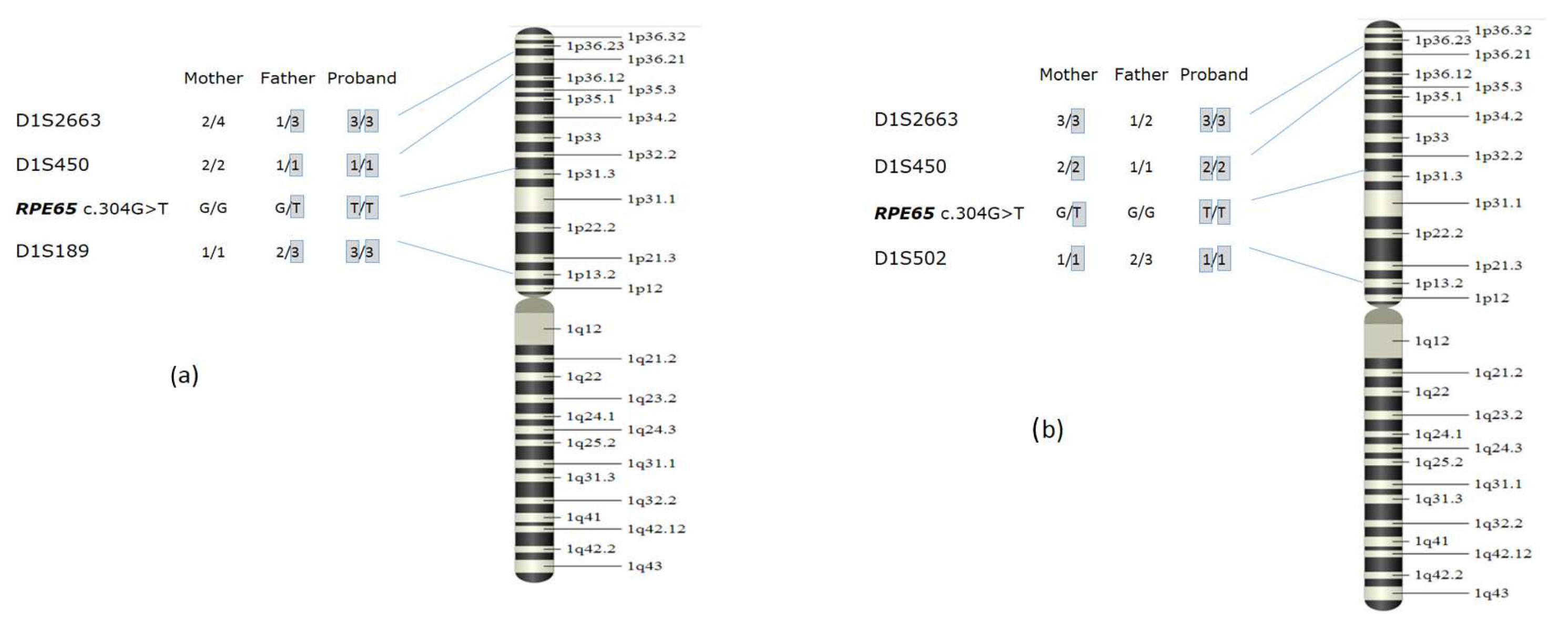
| Patient ID | Age at the Moment of Molecular Genetic Diagnosis | Sex | Place of Residence | Ethnic Group | Genotype | Nystagmus | Nyctalopia | Snellen BCVA | Central Foveal Retinal Thickness, µm | Color Vision Anomaly | ffERG | ||
|---|---|---|---|---|---|---|---|---|---|---|---|---|---|
| OD | OS | OD | OS | OU | OU | ||||||||
| 1 | 50 years | f | Chita region | Buryat | c.[370C>T]; [370C>T] | Yes | Full | 0.001 | 0.001 | 80 | 90 | MCh | ND |
| 2 | 5 years | m | Moscow region | Belarusian | c.[1451G>T]; [272G>A] | Yes | Full | 0.16 | 0.2 | 202 | 185 | Deu | Ext |
| 3 | 5 years | f | Kursk region | Russian | c.[1451-1G>A]; [304G>T] | No | inc | 0.2 | 0.2 | 134 | 129 | No | ND |
| 4 | 26 years | m | Buryatia | Buryat | c.[370C>T]; [370C>T] | Yes | Full | 0.01 | 0.01 | 90 | 102 | MCh | ND |
| 5 | 13 years | f | Dagestan | Lezgin | c.[1451G>A]; [1451G>A] | Yes | Full | 0.01 | 0.01 | 137 | 124 | Deu | Ext |
| 6 | 12 years | Yamalo-Nenets Autonomous Okrug | Russian | c.[982C>T]; [1340T>C] | No | inc | 0.3 | 0.16 | 230 | 247 | No | SubN | |
| 7 | 31 year | f | Irkutsk region | Russian | c.[304G>T]; [11+5G>A] | Yes | Full | 0.05 | 0.05 | 134 | 133 | MCh | ND |
| 8 | 6 years | m | Rostov region | Russian | c.304G>T(;) (304G>T) | No | inc | 0.4 | 0.4 | 153 | 158 | Tri | Ext |
| 9 | 3 years | m | Leningrad region | Russian | c.[11+5G>A]; [1565T>A] | Yes | Full | 0.2 | 0.2 | 176 | 176 | Tri | SubN |
| 10 | 9 years | m | Dagestan | Kumyk | c.[65T>C]; [65T>C] | Yes | inc | 0.6 | 0.7 | 170 | 185 | AnT | SubN |
| 11 | 6 years | f | Sverdlovsk region | Russian | c.[272G>A]; [304G>T] | Yes | inc | 0.05 | 0.05 | 182 | 221 | Dich | SubN |
| 12 | 36 years | f | Moscow region | Turkmen | c.[304G>]; [304G>T] | Yes | Full | 0.001 | 0.001 | 100 | 90 | MCh | Ext |
| 13 | 28 years | m | Moscow region | Russian | c.[1330C>T]; [595_596delAAinsT] | Yes | Full | 0.15 | 0.05 | 204 | 195 | MCh | ND |
| 14 | 24 years | m | Stavropol region | Russian | c.[304G>]; [304G>T] | Yes | Full | 0.01 | 0.01 | 199 | 216 | Dich | ND |
| 15 | 18 years | m | Bashkortostan | Bashkir | c.[271C>T]; [271C>T] | Yes | Full | 0.3 | 0.2 | 165 | 158 | AnT | ND |
| 16 | 12 years | m | Magadan Region | Russian | c.[304G>T]; [370C>T] | Yes | inc | 0.2 | 0.2 | 157 | 152 | AnT | SubN |
| 17 | 12 years | m | Sverdlovsk region | Tajik | c.[1450+1G>A]; [1450+1G>A] | Yes | inc | 0.1 | 0.05 | 213 | 271 | MCh | SubN |
| 18 | 11 years | m | Stavropol region | Dargin | c.[897C>A]; [897C>A] | Yes | Full | 0.05 | 0.2 | 234 | 215 | Tri | SubN |
| 19 | 4 years | m | Bryansk region | Russian | c.304G>T(;) (304G>T) | Yes | Full | 0.01 | 0.01 | 144 | 132 | AnT | Ext |
| 20 | 4 months | f | Smolensk region | Russian | c.[503T>A]; [304G>T] | No | inc | sv | sv | - | - | - | - |
| 21 | 1 year | m | Vologda region | Interethnic—Uzbek-Russian | c.[272G>A]; [725G>T] | Yes | inc | sv | sv | - | - | - | - |
| 22 | 5 years | f | Tuva region | Tuvan | c.[370C>T]; [1024T>C] | Yes | inc | 0.35 | 0.4 | 203 | 200 | Deu | Ext |
| 23 | 18 years | f | Moscow region | Russian | c.[230dup]; [272G>A] | Yes | Full | 0.1 | 0.16 | 271 | 245 | AnT | ND |
| 24 | 11 years | f | Leningrad region | Tajik | c.[1128G>A]; [1128G>A] | Yes | Full | 0.2 | 0.1 | 213 | 210 | Deu | Ext |
| 25 | 28 years | m | Omsk region | Russian | c.[617C>T]; [118G>A] | Yes | Full | 0.1 | 0.1 | 140 | 120 | MCh | ND |
| 26 | 4 years | f | Moscow region | Russian | c.[1307G>A]; [746G>A] | Yes | Full | 0.2 | 0.2 | 170 | 168 | AnT | Ext |
| 27 | 13 years | f | Tuva region | Tuvan | c.[370C>T]; [1024T>C] | No | Full | 0.3 | 0.3 | 172 | 180 | MCh | SubN |
| 28 | 43 years | m | Ivanovo region | Russian | c.[272G>A]; [11+5G>A] | Yes | Full | 0.001 | 0.001 | 186 | 134 | MCh | ND |
| 29 | 7 years | f | Buryatia | Kumyk | c.[1249G>C]; [65T>C] | Yes | Full | 0.4 | 0.4 | 189 | 179 | AnT | ND |
| № | Variant | Effect | Exon/Intron | № of chr. | Prevalence, % | Allele Frequency in gnomAD | References/Pathogenicity Criteria |
|---|---|---|---|---|---|---|---|
| 1 | c.304G>T | p.(Glu102*) | ex 4 | 13 (11) | 21.2 | 0.00003580 | [16] |
| 2 | c.370C>T | p.(Arg124*) | ex 5 | 7 | 12.0 | 0.00005674 | [4] |
| 3 | c.272G>A | p.(Arg91Gln) | ex 4 | 5 | 8.6 | 0.00004600 | [17] |
| 4 | c.11+5G>A | splicing | in 1 | 3 | 5.17 | 0.000078 | [18] |
| 5 | c.65T>C | p.(Leu22Pro) | ex 2 | 3 | 5.17 | 0.000028 | [19] |
| 6 | c.1024T>C | p.(Tyr342His) | ex 10 | 2 | 3.45 | n/a | [15] |
| 7 | c.1450+1G>A | splicing | in 13 | 2 | 3.45 | n/a | PVS1, PM2 |
| 8 | c.1128+1G>A | splicing | in 10 | 2 | 3.45 | n/a | PVS1, PM2 |
| 9 | c.1451G>A | p.(Gly484Asp) | ex 14 | 2 | 3.45 | 0.000008047 | [20] |
| 10 | c.271C>T | p.(Arg91Trp) | ex 4 | 2 | 3.45 | 0.000053 | [4] |
| 11 | c.897C>A | p.(Tyr299*) | ex 9 | 2 | 3.45 | n/d | PVS1, PM2 |
| 12 | c.725G>T | p.(Ser242Ile) | ex 7 | 1 | 1.72 | n/d | PM2, PP3, PP2, PM3 |
| 13 | c.230dup | p.(Thr78Hisfs*10) | ex 3 | 1 | 1.72 | n/d | PVS1, PM2,PM3 |
| 14 | c.1307G>A | p.(Gly436Glu) | ex 12 | 1 | 1.72 | n/d | [17] |
| 15 | c.746A>G | p.(Tyr249Cys) | ex 8 | 1 | 1.72 | 0.00001773 | [21] |
| 16 | c.1330C>T | p.(Pro444Ser) | ex 12 | 1 | 1.72 | n/d | PM2, PP3, PP2, PM3 |
| 17 | c.595_596delAAinsT | p.(Asn199Phefs*9) | ex 6 | 1 | 1.72 | n/d | PVS1, PM2 |
| 18 | c.1565T>A | p.(Ile522Asn) | ex 14 | 1 | 1.72 | n/d | PM2, PP3, PP2, PM3 |
| 19 | c.1451G>T | p.(Gly484Val) | ex 14 | 1 | 1.72 | 0.00001207 | [22] |
| 20 | c.1451-G>A | splicing | in 14 | 1 | 1.72 | 0.000004024 | [23] |
| 21 | c.1340T>C | p.(Leu447Pro) | ex 13 | 1 | 1.72 | n/d | [15] |
| 22 | c.982C>T | p.(Leu328Phe) | ex 9 | 1 | 1.72 | 0.039 | [24] |
| 23 | c.617T>C | p.(Ile206Thr) | ex 6 | 1 | 1.72 | 0.000012 | [25] |
| 24 | c.118G>A | p.(Gly40Ser) | ex 3 | 1 | 1.72 | 0.000028 | [4] |
| 25 | c.503T>A | p.(Leu168His) | ex 6 | 1 | 1.72 | n/d | PM2, PP3, PP2, PM3 |
| 26 | c.1249G>C | p.(Glu417Gln) | ex 12 | 1 | 1.72 | 0.000004 | [26] |
Disclaimer/Publisher’s Note: The statements, opinions and data contained in all publications are solely those of the individual author(s) and contributor(s) and not of MDPI and/or the editor(s). MDPI and/or the editor(s) disclaim responsibility for any injury to people or property resulting from any ideas, methods, instructions or products referred to in the content. |
© 2023 by the authors. Licensee MDPI, Basel, Switzerland. This article is an open access article distributed under the terms and conditions of the Creative Commons Attribution (CC BY) license (https://creativecommons.org/licenses/by/4.0/).
Share and Cite
Stepanova, A.; Ogorodova, N.; Kadyshev, V.; Shchagina, O.; Kutsev, S.; Polyakov, A. A Molecular Genetic Analysis of RPE65-Associated Forms of Inherited Retinal Degenerations in the Russian Federation. Genes 2023, 14, 2056. https://doi.org/10.3390/genes14112056
Stepanova A, Ogorodova N, Kadyshev V, Shchagina O, Kutsev S, Polyakov A. A Molecular Genetic Analysis of RPE65-Associated Forms of Inherited Retinal Degenerations in the Russian Federation. Genes. 2023; 14(11):2056. https://doi.org/10.3390/genes14112056
Chicago/Turabian StyleStepanova, Anna, Natalya Ogorodova, Vitaly Kadyshev, Olga Shchagina, Sergei Kutsev, and Aleksandr Polyakov. 2023. "A Molecular Genetic Analysis of RPE65-Associated Forms of Inherited Retinal Degenerations in the Russian Federation" Genes 14, no. 11: 2056. https://doi.org/10.3390/genes14112056
APA StyleStepanova, A., Ogorodova, N., Kadyshev, V., Shchagina, O., Kutsev, S., & Polyakov, A. (2023). A Molecular Genetic Analysis of RPE65-Associated Forms of Inherited Retinal Degenerations in the Russian Federation. Genes, 14(11), 2056. https://doi.org/10.3390/genes14112056









